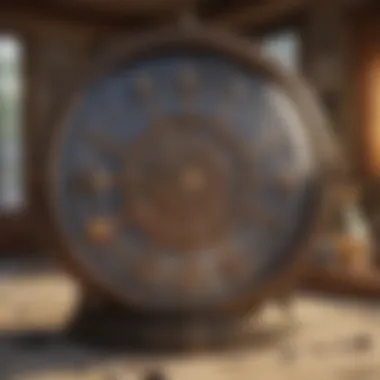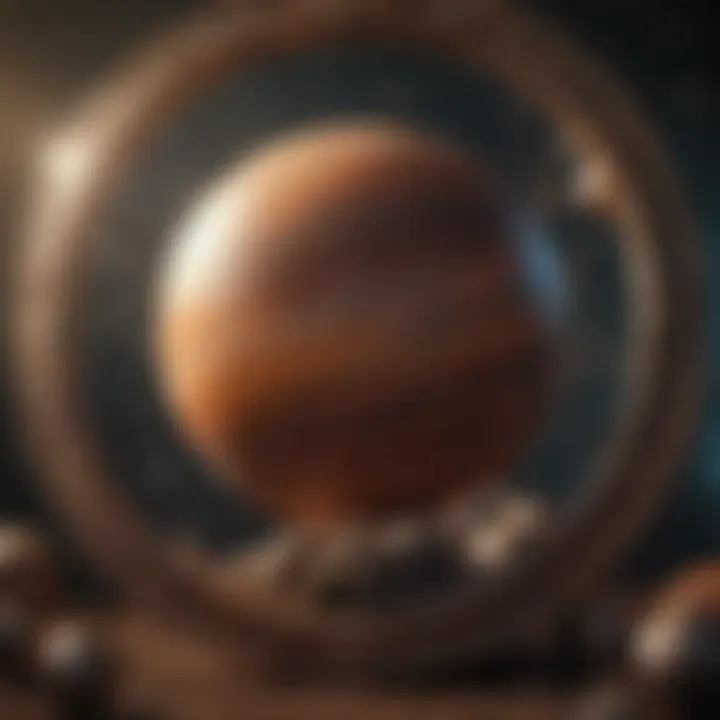Understanding Birth Charts and Their Importance in Astrology


Intro
Astrology is like a vast ocean teeming with mysteries, astrological lore, and personal significance. One of the cornerstones of this ancient practice is the birth chart, a celestial map that captures the positions of the planets at the moment of an individual's birth. As we navigate through the intricate world of astrology, understanding birth charts becomes a pivotal step for both newcomers curious about their stars and seasoned practitioners wishing to refine their interpretive skills.
The birth chart, often referred to as a natal chart, serves as a comprehensive blueprint of one's personality traits, life experiences, and potential future paths. By examining this map, one can discern the elemental influences that shape who they are. In the forthcoming sections, we shall dissect the components of birth charts, delve into the significance of planetary placements, and explore how these celestial arrangements interact to influence daily life, relationships, and personal growth.
This article sets the stage for an analytical journey into birth charts, aimed at enhancing the reader's understanding of themselves and others through the lens of astrology. By fleshing out these celestial coordinates, we will unravel the rich tapestry of advantages and challenges inherent in one's starry companions.
Characteristics of Each Zodiac Sign
Each zodiac sign possesses its unique personality traits that render it distinct from others. Understanding these characteristics not only aids in grasping one's own nature but also facilitates interpersonal relations. Here’s a closer look:
Overview of Personality Traits
- Aries: Bold and adventurous, they’re the pioneers of the zodiac.
- Taurus: Grounded and reliable, they cherish stability and comfort.
- Gemini: Quick-witted and sociable, they thrive on variety and interaction.
- Cancer: Nurturing and intuitive, they prioritize family and emotional connections.
- Leo: Charismatic and confident, they seek attention and admiration.
- Virgo: Detail-oriented and analytical, they strive for perfection.
- Libra: Diplomatic and fair-minded, they value harmony and relationships.
- Scorpio: Intense and passionate, they delve deep into the complexities of life.
- Sagittarius: Passionate and philosophical, they crave knowledge and adventure.
- Capricorn: Disciplined and ambitious, they set high standards for themselves.
- Aquarius: Innovative and unique, they cherish individuality and humanitarian efforts.
- Pisces: Compassionate and artistic, they are dreamers who feel deeply.
Strengths and Weaknesses
It's vital to recognize that while each sign has strengths, they also have weaknesses:
- Aries: Strength - Courageous; Weakness - Impulsive.
- Taurus: Strength - Dependable; Weakness - Stubborn.
- Gemini: Strength - Adaptable; Weakness - Inconsistent.
- Cancer: Strength - Compassionate; Weakness - Moody.
- Leo: Strength - Generous; Weakness - Arrogant.
- Virgo: Strength - Practical; Weakness - Overcritical.
- Libra: Strength - Graceful; Weakness - Indecisive.
- Scorpio: Strength - Resourceful; Weakness - Jealous.
- Sagittarius: Strength - Open-minded; Weakness - Tactless.
- Capricorn: Strength - Responsible; Weakness - Pessimistic.
- Aquarius: Strength - Original; Weakness - Detached.
- Pisces: Strength - Empathetic; Weakness - Escapist.
Compatibility with Other Signs
The zodiac is a tapestry of interactions; certain signs mesh better than others. For example:
- Aries and Leo generally ignite a blazing romance.
- Taurus and Capricorn often build sturdy partnerships.
- Gemini and Libra usually engage in lively conversations.
- Cancer and Scorpio share profound emotional connections.
- Sagittarius and Aquarius often explore life’s adventures together.
Understanding these dynamics can offer insights into forming and nurturing relationships, helping individuals navigate their social and romantic lives with greater ease.
Understanding Birth Charts
The birth chart is made up of various elements that harmonize to create a comprehensive narrative of an individual’s astrological identity. Let's get down to the nitty-gritty of how to interpret these celestial maps.
Foreword to Birth Charts
Birth charts, often referred to as natal charts, serve as intricate maps of the celestial placements at the moment of one's birth. They provide a unique synthesis of astrological elements, detailing how each planetary position interacts with the individual’s personality and life path. Understanding birth charts is not merely an esoteric exercise but a profound endeavor that can yield valuable insights for personal growth and self-awareness.
Historical Context of Astrology
Astrology’s roots dig deep into antiquity, blossoming in various cultures across the globe. The ancient Babylonians were among the first to chart celestial movements, observing the patterns of planets and stars to develop early astrological systems by around the second millennium BCE. The Greeks later refined these ideas, blending them with philosophy and mathematics, giving birth to a framework that is still relied upon today.
Astrology was integral to several historical civilizations, from Mayan society to Renaissance Europe. The alignment of planets was often believed to influence not just individuals but also the fate of nations. However, centuries of scrutiny and skepticism have led to astrology being viewed through a more critical lens in modern times. Despite this, the enduring allure of astrology persists, shaping our understanding of how celestial phenomena connects with earthly experiences.
Purpose and Relevance of Birth Charts
Why should one delve into their birth chart? One might ask. Well, for a start, birth charts act as comprehensive blueprints of our inner selves. They emphasize not only who we are but why we might react in certain ways.
- Self-Reflection & Personal Growth: By exploring the intricacies of a birth chart, one can better grasp their motivations, fears, and strengths.
- Relationship Dynamics: Understanding the different components of one's birth chart can significantly enhance interpersonal relationships. For instance, knowing your partner's Venus or Mars placements can offer insights into their love language and desires.
- Life Patterns and Opportunities: Birth charts can reveal celestial cycles that align with personal development opportunities, allowing individuals to navigate life’s pathways with more confidence.
Many find solace in interpreting their birth charts or those of others. This exploration can lead to not just individual revelations but also enriched communal connections.
"The cosmos is within us. We are made of star-stuff. We are a way for the universe to know itself." - Carl Sagan
Core Components of a Birth Chart
Understanding the core components of a birth chart is essential not just for astrological practitioners, but for anyone looking to gain deeper insight into their life's trajectory. Each element plays a vital role in shaping the individual characteristics and life experiences of a person. This section will explore the various components, their significance, and how they collectively weave the intricate tapestry of one’s astrological profile.
The Zodiac Signs and Their Influence
The twelve zodiac signs serve as the foundation of astrological interpretation. Each sign embodies unique qualities and characteristics. For instance, Aries is often seen as bold and impulsive, while Pisces is empathetic and dreamy. The influence of these zodiac signs goes beyond mere personality traits; they can also shape how individuals interact with the world around them.
- Elemental Associations: Each zodiac sign belongs to one of four elements: Fire, Earth, Air, and Water. This elemental distinction adds another layer to understanding the personality. For example, Fire signs are typically associated with energy and dynamism, while Earth signs may lean towards practicality and stability.
- Modalities: Along with elements, the signs are classified into three modalities: Cardinal, Fixed, and Mutable. Cardinal signs initiate action, Fixed signs maintain it, and Mutable signs adapt to change. This classification offers insight into how people approach challenges and transitions in life.
The signs not only describe us but also reveal how we process experiences and interact with our surroundings.
Essential Planets in Astrology


Planets are much more than celestial bodies; they act as archetypes representing various aspects of human experience. The essential planets in astrology include the Sun, Moon, Mercury, Venus, Mars, Jupiter, Saturn, Uranus, Neptune, and Pluto. Each planet governs specific traits and influences, offering a nuanced perspective on individual behaviors.
- The Sun symbolizes ego and conscious self-expression.
- The Moon ponders emotional instincts and inner moods.
- Mercury manages communication and intellect.
- Venus embodies love, beauty, and relationships.
- Mars fuels ambition and assertiveness.
Understanding planetary placements within a birth chart can illuminate personal strengths, weaknesses, and areas for growth. Moreover, their interactions can suggest potential challenges or opportunities in one's life path.
Astrological Houses Explained
Astrological houses are instrumental in contextualizing planetary influences. The birth chart is divided into twelve houses, each depicting different life areas. For instance, the First House relates to self-image, while the Seventh House governs partnerships and relationships.
- Personal Realm: The First, Fourth, and Tenth Houses delve into personal identity, home life, and career. Here we find insight into how individuals see themselves and their goals in life.
- Relational Aspect: The Seventh and Eighth Houses explore themes of relationships, intimacy, and shared resources, revealing dynamics that might come to play in personal connections.
- Transcendental Houses: The Ninth and Twelfth Houses invite exploration into philosophy, spirituality, and the unconscious, often guiding existential questions.
Understanding Aspects and Their Importance
Astrological aspects examine the angles formed between planets within a birth chart, revealing the dynamics at play. These angles can signify harmony or tension, impacting personal life experiences.
- Conjunctions capture energies merging together, creating powerful influences.
- Squares bring challenges, often serving as catalysts for growth.
- Trines showcase harmony and ease, fostering supportive relationships.
The significance of understanding aspects lies in their ability to provide a broader perspective on internal conflicts or strengths. Decoding these interactions can guide individuals toward better self-awareness and informed decision-making.
In summary, the core components of a birth chart reveal a multi-faceted understanding of an individual’s astrological identity. The interplay of zodiac signs, planets, houses, and aspects creates a rich narrative, allowing for a deeper comprehension of oneself and others in a constellation of influences.
Calculating Your Birth Chart
Understanding how to calculate your birth chart forms the bedrock of astrological insight. It’s much more than just scribbles on a piece of paper; it’s a map of your cosmic DNA. By pinpointing the positions of celestial bodies at the moment of your birth, the chart yields critical information about personality, relationships, and life events. The significance behind this calculation lies in the precision of the data utilized. The more accurate your details, the clearer the insights.
Gathering Required Information
Before you can dive into the numbers and calculations, you need the specifics. Having your birth details on hand is vital. Let’s break this down into three essential components:
Date of Birth
Your date of birth represents the first piece of your astrological identity. This unique identifier helps in determining your Sun sign, which is often what people refer to when they ask, "What’s your sign?" The Sun sign suggests general traits, motivations, and character tendencies. Due to its prominence, knowing your date of birth is not just a beneficial choice; it’s essentially the North Star in the astrological map.
One could argue that the appeal of the date of birth is its accessibility; anyone can easily obtain their birth date. However, what’s unique about it is the way it connects with your life's narrative, reflecting the cosmic energies present on that particular day. A downside could be that relying solely on this date might lead one to overlook complex factors from the other necessary elements. So, remember, while your date of birth is crucial in calculating your chart, it’s only one part of a larger puzzle.
Time of Birth
Ah, the time of birth. This one can often feel like a race against the clock—pun intended—because precision is key here. You see, the time defines your Moon and Rising signs, which add layers to your astrological profile. The Moon sign governs emotions and instincts, while the Rising sign (or Ascendant) depicts how you present yourself to the world.
A unique aspect of the time of birth is its fluid nature; a few minutes here or there can sometimes shift the Ascendant, changing your entire outlook and first impression. Many would emphasize the necessity of having an accurate time, as it acts like the icing on the cake that enhances the features of your astrological makeup. Of course, the trade-off? Some might find difficulties in obtaining this precise timing, especially if birth records are imprecise or missing.
Place of Birth
Lastly, we arrive at the grounding element—place of birth. This detail provides the geographical coordinates needed to calculate the correct astrological houses and aspects. Each house in a chart reflects different life areas, such as career, relationships, and home.
West, east, north, or south, where you were born shapes your astrological experience on a significant level. A particular characteristic of this detail is its potential for meaning—each locale might imbue different cultural connotations into your life, lending a unique twist to your personality traits. However, it’s also true that shifts in birth location can be complex to interpret. As a rule of thumb, it’s advisable to use the exact place where you took your first breath, as the energies around you have a role in molding your astral needs.
Using Online Tools for Chart Generation
With this foundational information in hand, you can turn your attention to astrology software or websites that can generate charts based on the parameters you provide. These tools can often be a breath of fresh air, especially for newcomers. They simplify the intricate calculations into a user-friendly format. However, keep an eye on the sources you use because certain platforms may vary in their level of accuracy and detail. High-quality astrological tools can empower you by giving a clear picture of the celestial placements.
Interpreting Generated Charts
So, now you’ve got your birth chart; what’s next? Getting accustomed to interpreting the generated charts is the next part of the journey. At first glance, it can seem overwhelming—lines, symbols, all dancing around like bees in the summer sun. The key is to approach each element methodically. Start by identifying the signs, then move on to houses and aspects. Each layer reveals a deeper understanding of your personality and intrinsic motivations, so don’t rush the process. Take the time to explore each part; the insights will unfold like pages in a well-worn book.
"Astrology is a language. If you understand this language, the sky speaks to you."
- Dane Rudhyar
As you decode your chart, consider the broader themes that unfold, guiding you towards personal growth and clarity. Remember, this astrological journey is uniquely yours—embrace it.
Deciphering the Elements of Your Chart
Understanding your birth chart can feel like piecing together a cosmic jigsaw puzzle. Each element holds its unique significance, weaving an intricate tale of your individuality. The sun, moon, and rising signs, along with planetary placements, each play a pivotal role in shaping who you are and how you interact with the world. This section dives deep into these elements, providing insights that can elevate your self-awareness and personal growth.
Analyzing Sun and Moon Signs


Your sun sign, usually the most recognized aspect of astrology, represents your core identity. It embodies your ego, willpower, and the basic essence that drives you. Meanwhile, the moon sign delves into your inner self, shedding light on your emotional landscape and subconscious motivations.
Think of your sun sign as a theatrical performance where you are the star. It's your public persona, the face you show the world. On the other hand, your moon sign serves as the script, often hidden from view but deeply influences your actions and reactions. For instance, a person with a Leo sun might radiate confidence and ambition, yet if their moon is in Cancer, they may find comfort in nurturing relationships and a cozy home. Grasping the dynamics between these signs can yield profound revelations about your personality.
Exploring Rising Signs
The rising sign, or ascendant, is essentially the mask you wear when meeting others for the first time. It forms the initial impression that people have of you, often relating to your outward behavior and the way you present yourself. It's crucial to recognize that this sign operates at the interface between your internal and external worlds, influencing how you engage with life's experiences.
For instance, someone with a Scorpio rising may be perceived as intense or mysterious, regardless of their sun’s demeanor. This creates a fascinating dance between intrinsic personality traits and the impact of external perceptions. Your rising sign sets the stage for the adventures depicted in your birth chart, determining how you approach situations.
Understanding Planetary Placements
Planetary placements paint a more colorful picture of your personality and potential. Each planet in your chart symbolizes different facets of life—from communication (Mercury) to love (Venus) to transformation (Pluto).
By examining where these planets reside within the zodiac signs and houses, you can uncover specific influences they have on your life. For example, if Venus is located in fiery Aries, you might experience love with vigor and spontaneity. Saturn, meanwhile, might have you learning lessons through discipline where it finds its home, perhaps in Capricorn, influencing a pragmatic approach to your aspirations.
Using a blend of signs and placements, you start to unveil the complex tapestry that defines you. Each element unveils a layer to your identity, showcasing how your individuality is influenced by the universe’s grand design. A thorough analysis of these components not only enriches your astrological understanding but also enhances your personal growth on this ever-evolving journey.
As you delve into your birth chart, remember that every person’s matrix of signs is unique, reflecting their cosmic fingerprint.
By grasping these elements—sun and moon signs, rising sign, and planetary placements—you’re not merely reading a chart; you’re engaging in an enlightening exploration of who you are.
The Role of Transits in Astrology
In the intricate tapestry of astrology, transits hold a significant position. They reveal how the movement of planets—both visible and invisible—affects an individual's birth chart over time. Understanding this dynamic aspect is essential for both running the shop as an astrologer and digging deep into personal insights. Transits can illuminate periods of change, opportunities for growth, and even foretell challenges ahead. Recognizing how these celestial movements impact one’s chart helps in making informed decisions, leading to personal fulfillment and enhanced understanding of life’s ebbs and flows.
What Are Transits?
Transits refer to the ongoing movement of planets as they relate to the fixed positions of the planets in an individual’s birth chart. Simply put, as planets navigate through the sky, they form angles and relationships with the natal placements. Each planet—be it Mars, Venus, or even the slower giants like Saturn—carries its own energy and story. When we observe these movements, we can decipher the generally transient but impactful energies that might be influencing various life events and emotional states.
The concept of transits can be traced back to ancient janes of astrological study, where the movements were not merely looked at as celestial mechanics, but as vital actions of influence, embedding deeper meaning and real-world resonance. Transits are not static; they are happening every moment, like the tick of a clock—always unfolding.
How Transits Affect Birth Charts
Transits can affect an individual's birth chart in several profound ways. The influence can vary dramatically, depending on which planet is transiting and how it interacts with the natal placements. Here are some effects commonly observed:
- Short-term vs. Long-term: Some transits are fleeting, providing quick shifts in emotion or perspective. Others, like those from Saturn or Pluto, can last for years, inciting deep transformative changes in one's life.
- Positive and Challenging Energies: The nature of the transit plays a crucial role; positive aspects like trines or sextiles might assist in growth and creativity, while challenging aspects such as squares or oppositions may stir up trouble, prompting a need for reflection or action.
- Timing Events: The position of the transiting planets in relation to the houses of the birth chart can signal when certain life events might take place. For example, a transit through the 7th house might suggest significant relationship developments.
"Transits are like the weather; they can dictate the present moment and hint at future storms or sunny days."
- Growth Opportunities: Transits act as catalysts for personal growth. A turbulent transit might lead to uncomfortable scenarios, yet those very scenarios can push a person towards self-discovery or deeper understanding of their innate traits and potentials.
- Life Stages: Certain transits correspond with developmental stages in life. For instance, the Saturn return, occurring roughly around age 28-30, often marks a pivotal life shift.
Applying Birth Chart Knowledge
Understanding how to apply your birth chart knowledge is not just an academic pursuit; it's about using the insights gleaned from the celestial arrangement at your time of birth to enhance the quality of your life. Interpreting a birth chart can reveal your strengths, weaknesses, and even peculiar traits that might seem like mere quirks. This understanding can then become a powerful tool for personal growth, allowing you to navigate life with more clarity and purpose.
"The stars may cast their light on our paths, but it is our choices that define which roads we take."
Personal Development Insights
When it comes to personal development, your birth chart serves as a roadmap. For example, your Sun sign tells you where your core strengths lie, enabling you to focus on them. If your Sun is in Leo, you might have a natural flair for leadership. Recognizing this can encourage you to seek out roles where you spearhead initiatives, thus fostering growth and advancement in your career.
Understanding your Moon sign can enhance emotional intelligence. If your Moon is in Cancer, for instance, nurturing relationships or fostering a sense of community comes naturally to you. These insights can lead you to explore career paths that involve care-giving or community service, aligning personal satisfaction with professional success.
Here are a few practical ways to harness birth chart insights for personal development:
- Set realistic goals: Know your astrological strengths and weaknesses. For instance, if you have a lot of planets in Capricorn, your drive and pragmatism can be leveraged in career goals.
- Embrace challenges: By understanding areas where you might struggle, you can build resilience. Those with strong Sagittarius placements might be naturally restless; knowing this can help you channel that energy effectively.
- Cultivate awareness: Recognizing personality patterns can aid in emotional regulation. Scorpio placements, often known for intensity, can work towards balancing their deep emotions by practicing mindfulness.
Navigating Relationships
Relationships are often a labyrinth, and understanding your birth chart can illuminate paths to healthier interactions. Astrological insights provide context for interpersonal dynamics, piquing your awareness of not just your behaviors but also those of your loved ones.
Your Venus sign reveals how you express affection and what you value in relationships. For example, a Venus in Gemini might seek intellectual stimulation in a partner, while someone with Venus in Taurus may prioritize stability and material comfort. This knowledge can help you communicate your needs effectively and set expectations early on.
Additionally, examining the aspects between your chart and the charts of those close to you can clarify complex dynamics.
- Synastry charts, which analyze the relationship between two birth charts, can shine light on compatibility. If you notice trines and sextiles (harmonious aspects) between your charts, it may indicate a smooth relationship, while squares and oppositions (challenging aspects) could suggest friction.
- Understanding your partner’s Moon sign allows you to better gauge their emotional needs. A partner with a Moon in Aquarius might value independence, providing you the insight to respect that space.


To summarize, applying knowledge from your birth chart empowers you both personally and relationally. It invites not only deeper self-understanding but also richer relationships, steering you towards fulfilling connections and a more satisfying life.
Common Misconceptions about Birth Charts
Interpreting birth charts can feel like navigating a tempestuous sea of information. With each wave of knowledge, one encounters various misconceptions that tend to muddy the waters. It’s vital to clear the air around these misunderstandings to fully embrace the power of astrology and its implications in our lives.
Astrology Versus Astronomy
At first glance, astrology and astronomy might seem like two peas in a pod, but they couldn't be more different. Astronomy is the scientific study of celestial bodies, including planets, stars, and galaxies. It's grounded in physics, mathematics, and observation, churning out measurable data and predictions based on physical laws.
Astrology, on the other hand, swims in more subjective waters. It seeks to interpret how celestial movements correlate with human experiences and personality traits. The crux of the confusion arises from the overlapping vocabulary and focus on celestial events. Many folks might say, "If it ain’t science, it ain’t real," leading to the dismissal of astrology altogether. This misconception belies the profound significance that such cosmic configurations hold in many cultural contexts. Recognizing that these are two distinctive fields can deepen one's understanding of astrology and its role in human experiences.
Debunking Myths
Myths about astrology are as common as dirt. One prevalent myth is that one's sun sign is the only thing that matters in a birth chart. While the sun sign signifies core personality traits, it’s merely the tip of the iceberg. The moon sign, rising sign, and planetary placements fill in the bigger picture, revealing the complex mosaic that is a person's character.
Another misbelief is that astrology is deterministic, suggesting that it dictates our choices and outcomes without any room for free will. While birth charts provide insights into tendencies and inclinations, they don't tie one into a predestined script. Life is more about choices and how we leverage the information astrology provides.
Some highlight that astrology is too general. There’s truth in that; horoscopes can feel like cookie-cutter advice. Yet, a detailed birth chart analysis is nuanced, diving deep into factors like aspects and houses that can yield unique interpretations. Misunderstandings often stem from a lack of knowledge or selective engagement with the material, leading to erroneous conclusions.
To summarize, addressing these misconceptions enriches our understanding of how birth charts operate within astrology’s framework. They aren’t standalone entities floating in void, rather they interconnect intricately with our daily lives, providing wisdom and guidance:
“The stars incline; they do not bind.”
Enlightenment begins with recognizing the layers and complexities of astrological practice. Embracing these insights not only aids in personal growth but also enhances the rich tapestry of human experience.
Further Resources for Astrological Study
To deepen one’s understanding of birth charts and astrology overall, exploring additional resources is crucial. These resources provide valuable insights, historical context, and practical applications that go beyond the basics present in this article. For those who truly want to enhance their astrological knowledge, leaning into these avenues can make all the difference. Here, we will look into several key areas: books and literature, online courses and workshops, and astrological software and apps. Each of these categories holds unique value for anyone intrigued by astrology.
Books and Literature
Books are a timeless gateway to knowledge, and in astrology, they hold immense significance. From classic texts to contemporary guides, the variety is vast. Here are a few notable aspects of why books should be part of your astrological toolkit:
- In-Depth Knowledge: Many books offer extensive information that can help you understand complex concepts without the limits of online snippets.
- Historical Context: Works like Ptolemy's Tetrabiblos or Astrology: Using the Wisdom of the Stars in Your Everyday Life are excellent for grasping how astrological thought has evolved over centuries.
- Specific Focus: Whether you’re interested in natal astrology or predictive techniques, books often specialize in areas that target your needs.
Some highly recommended titles include:
- Astrology for the Soul by Jan Spiller
- The Only Astrology Book You'll Ever Need by Joanna Martine Woolfolk
- Parker's Astrology: The Definitive Guide by Julia and Derek Parker
These texts can serve as your companions on your astrological journey, guiding those who seek knowledge beyond a surface level.
Online Courses and Workshops
In today’s digital age, online courses have revolutionized education across various fields, astrology no less. Engaging in courses and workshops allows learners to ask questions, participate in discussions, and get feedback. How beneficial can these opportunities be?
- Interactive Learning: Unlike passive reading, courses encourage engagement and discussion among peers and instructors, enhancing retention of information.
- Structured Formats: Many online platforms design courses systematically, offering clear progression from fundamental concepts to advanced techniques.
- Expert Insights: Often, these courses feature seasoned astrologers sharing their expertise, which can lead to more nuanced understandings.
Look into platforms like Udemy, Coursera, or even dedicated astrology websites that offer specialized classes. Attend workshops hosted by experienced practitioners to gain hands-on experience and network within the astrological community.
Astrological Software and Apps
For those who want to put theory into practice, astrological software and apps are invaluable tools. They cater to both newbies and veterans in easily generating birth charts and performing complex calculations. Here are key points to consider:
- User-Friendly Interfaces: Most tools are designed with ease of use in mind, making them accessible for beginners.
- Comprehensive Features: Advanced software can provide detailed analyses that go beyond basic chart views. Look for options that generate reports on transits, progressions, and synastry.
- Convenience on the Go: Mobile apps allow enthusiasts to explore astrology anywhere, anytime, making learning part of daily life.
Some popular software includes AstroSeek and Solar Fire, while apps like TimePassages offer solid mobile options. Invest in these tools to empower your astrological practice.
"Navigating the stars isn’t solely about charting; it’s also about understanding the rich tapestry of knowledge that surrounds astrology."
Whether it's through books, engaging online courses, or exploring practical tools, continuing your astrological study enhances your understanding of birth charts profoundly. Each resource adds a layer to your knowledge, paving the way for deeper insights into yourself and the universe.
End
In the grand tapestry of astrology, the conclusion serves as a crucial anchor, pulling together the myriad threads of information discussed throughout this article. A birth chart is not merely a static diagram; it’s a living tool that can illuminate your path in ways you might not even have thought possible. Understanding how the elements of the chart interact can offer a transformative perspective on life, shaping personal growth and self-awareness.
Key Elements of Epilogue
- Integration of Knowledge: The conclusion synthesizes the various components of a birth chart—zodiac signs, planetary placements, houses, and aspects—tying them together in a cohesive understanding of how they collectively influence individual experiences.
- Benefits of Astrological Insight: Embracing your birth chart empowers you to take a proactive approach to your life's journey. It provides clarity when faced with choices or challenges and helps navigate the complexities of human relationships through a nuanced understanding of yourself and others.
- Considerations on Continued Learning: Astrology is not just a one-time study; it’s a lifelong adventure. Many astrological experiences extend beyond personal charts into societal trends and global themes. This continuous exploration allows for deeper layers of comprehension, where curiosity fuels growth.
The importance of this conclusion lies in its role as a reflective moment. It encapsulates the importance of harnessing astrological knowledge for personal development and greater connection with the world around us. A birth chart can deeply enrich your understanding of yourself, equipping you with tools to navigate life’s ebbs and flows more skillfully.
"Every action has repercussions written in the stars. To ignore them is to invite chaos into your life."
So as you close this chapter on understanding birth charts, remember that this is just the beginning. Each planetary shift, each transit can offer you a wealth of information, if only you’re willing to look up and comprehend the celestial messages tailored just for you.







